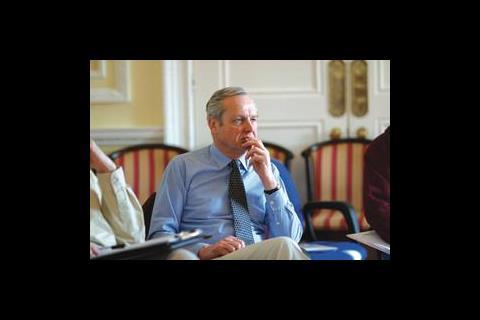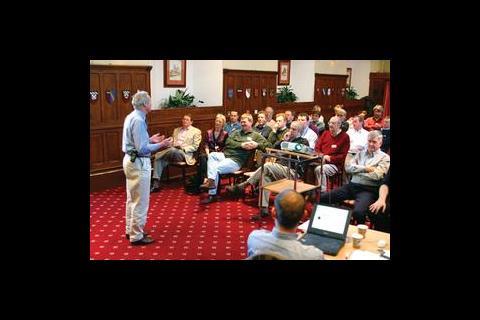What the outcome did lack however, was a clear vision of what building services might look like in 2010, especially in terms of client requirements. There are a number of explanations for this. Firstly, two days' thinking time isn't enough to work out all the permutations resulting from working in new ways such as partnering or prefabrication, utilising technology, or training staff differently. Also, 2010 isn't that far away, and for many delegates the idea that we will have solved all the problems the industry faces in a short span of seven years, seems unlikely – and you can't blame them.
That said, it's important to highlight what Think 2010 did achieve. There was a clear view of where building services is today, and probably will be in the immediate future. There were also indications of what industry leaders would like to see government, institutions and businesses doing to overcome problems, to achieve greater efficiency, and better buildings. The sponsoring institutions of Think 2010 were CIBSE, the Electrical Contractors' Association, the Heating and Ventilating Contractors' Association, the Federation of Environmental Trade Associations and BSRIA. These bodies will take the findings of the weekend event and create a declaration of intent; a joint development strategy which will aim to give new impetus to the industry.
The declaration will be published later in the year by BSRIA. In the meantime, BSj was at Think 2010 to pick up what the industry considers the major issues in the near future. Ours is not a detailed feedback, but a comprehensive review of the kind of subjects under discussion, and a gathering together of the key thoughts from delegates.
Before discussions commenced, a few people gave presentations of their general thoughts on questions that the industry needs to answer. John Sharp of NG Bailey felt that the challenges the industry faces are not only technical, but also cultural. "We must change what we do, not just do the same thing better," he commented.
Eddie Brown of the Electrical Contractors' Association said that in the UK mechanical and electrical engineering is undervalued. "How can we persuade customers to understand the importance of m&e in making their buildings work? If we don't do this, how can we move away from price-led buying of products." He also raised the interesting point of professionalism among engineers and asked if there should be an acceptable level of minimum cost. On the subject of best-value analysis he called for realism: "We often pay lip service to best value, and it still means 'cheapest price' to many clients."
Ron Edmonson, managing director of Waterloo Air Management, focused on the aim of saving 50% of the cost of buildings, through the integration of supply chains. Edmonson demonstrated the 1:5:200 rule. "A £1 million building costs £5 million to run over five years, and what the people do in that building creates £200 million. So if people could work better, then a small increase of capital investment in the building, would have a huge impact on business." Edmonson closed by saying that the agenda for change is "a good opportunity to show clients that we can deliver on our promises."
The first and main discussion of Think 2010 revolved around the question "What are clients' business requirements today and in the immediate future?". Delegates broke up into four groups, reporting back with findings in plenary sessions. (For the purposes of reporting, group discussions were anonymous.)
Before we ask what clients want, we need to know who they are. In some cases, there is more than one client to consider.
Clients. Who are they?
The main issue for delegates was "who is the client?". "Our difficulty," said one commentator, "is that the person who pays for the building isn't necessarily the occupier. The client could be said to be the main contractor, another consultant, the end user... the next person up the supply chain." The other difficulty is deciding whose needs are the most fundamental, given that there are effectively multiple clients with multiple needs.
Of course, getting down to the fundamentals of client requirements will inevitably lead to discussions of money. "What clients want is lowest cost, and best value," commented one delegate, reflecting the views of many in the construction industry. All agreed that underspending was a real problem for the industry. "Money, and how it's used and the results of spreading it too far is a terrible malaise which leads to user dissatisfaction, high cost in use, and refurbishment after a few years," said one speaker. The general feeling is that cost cutting is one of the worst problems faced by the industry, leading to poor buildings, and even encouraging bad working practices such as black market working due to the low cost aims of clients.
One key solution to these problems is to educate clients better; give them good information on which to base intelligent decisions. "Very often, the client doesn't know what he wants. The client doesn't know how to get the best out of construction, and the construction industry doesn't understand the client's business." This pointed to the quantity surveyor as the main source of information to clients. "The qs is a money man, so the client can understand their terminology better. But the qs has little understanding of the technical side."
It was also felt that client expectations could be raised too high – that they think they can get more for their money than is possible. There was a general call for better data on the operating costs of buildings, in order to clarify the issue of whole life costing for clients.
"We have to get closer to the clients. If we don't know the needs of the end-user, someone in the supply chain does, and we should share that information." Delegates described an 'education gap' between clients and construction which needs to be closed. "Clients do believe in value, they just don't know how to achieve it."
PFI projects, which have come in for so much criticism in general, were praised as creating a better climate in which to build. "PFI projects supply feedback, so we can learn from past projects. Also, where the facilities contractor is part of the consortium, we have to be very careful about our choice of plant. We have to buy with a long-term view." It was felt that perhaps PFI could have a positive effect on the way the industry procures.
Skills and competencies required for the future were also discussed. Delegates agreed that the industry would see a fundamental change in training and education needs. Integrated working will result in the need for "less depth and more width" in skills. It was predicted that with the increase of pre-fabrication off-site, there would be a need for lesser skilled workers. However, the positive aspect of this was seen as better working conditions, possibly attracting more women to the industry.
The industry has to invest more in training its future managers to higher standards, to meet the needs of clients
New skills will be needed at the technical management level. This could include creation of workers who can operate 3D modelling software, and use virtual planning tools – both of which are seen as vital elements in the construction industry of the future.
Without doubt, the industry has to invest more in training. Across the board, there was a call for integration of training courses. This would apply even to the higher levels of engineer and architect sharing a foundation course in general construction techniques before specialising.
Making better managers
The new form of training would also help to bring down barriers between professions in construction. Delegates commented that universities need better briefing from the industry. But it was also viewed as vital that the government rebuilds confidence in vocational training.
Many delegates felt that while they had risen through the ranks from engineers and technicians to director level, it was no longer possible to be a leader in the construction industry without good management training. They suggested that courses should include elements of management and business studies. Lack of management skill in construction might also be tackled by encouraging experienced individuals from the automotive sector, for example, to lend their expertise.
One of the key business questions that delegates considered was whether rationalisation of the sector is likely, or desirable. One speaker pointed out that there are 75 air plant manufacturers in the UK, but only 10 in France, and therefore rationalisation was unavoidable for the UK building services sector. Some also felt that work would inevitably move abroad, with some manufacturing already going to China to take advantage of lower costs.
Rationalisation was seen to have several benefits, including removal of duplication, better connections between supply chain members, removal of excess capacity, increased efficiency, and the ability to offer clients a one-stop-shop.
Delegates felt that the industry could prepare itself for a rapidly shrinking industry by focusing on offering clients not just products, but solutions. It was also felt that the associations and research bodies should rationalise, cutting back duplication of effort which often happens today.
At the end of discussions, and on the positive side, it seemed that most delegates saw partnering, teamworking and supply chain management as the best methods to achieve a more productive and profitable industry.
List of delegates
Julian Amey, CIBSESimon Bartley, S4 Consulting
Eddie Brown, Electrical Contractors’ Association (ECA)
Tony Carroll, CK Electrical Installations
Hywell Davies, CIBSE
Michael Dickson, Buro Happold Management
Ian Durbin, Hoare Lea Consulting Engineers
Derrick East, Accolade Building Services
Andrew Eastwell, BSRIA
Ronald Edmonson, Waterloo Air Management
Michael Ensor, Ensor Consulting
Rodger Evans, DTI
Paul Everall, Office of the Deputy Prime Minister
Paul Fletcher, Architecture FAB
Andy Ford, Fulcrum Consulting
Oliver Griffiths, Corporate Responsibility Consulting
Bob Harris, RT Harris & Son
Robert Higgs, Heating and Ventilating Contractors’ Association
Trevor Hursthouse, Goodmarriott & Hursthouse
Glen Irwin, Roberts & Partners
Denice Jaunzens, FaberMaunsell
Richard John, FaberMaunsell
Donald F Leeper, Zisman Bowyer & Partners
Doug Marriott, Safeway
Alan McDougall, Shepherd Engineering Services
John Moore, Crown House Engineering
Mike Murray, Panassus
Steve Newbold, ECA
David Pollock, ECA
Kevin Preston, Preston Lee Chambers
CJ Rhodes, Brown & Co (E.E)
Tanya Ross, Buro Happold Management
David Saffin, Zisman Bowyer & Partners
John Sharp, N G Bailey
Hugh Soden, Soden & Brook Consulting Engineers
Russell Solts, ASEAS UK
Quentin Spratt, Rite-Vent
Gerry Stapley, Eaton-Williams
Rodney Turtle, Schneider Electric
Chris Twinn, Arup
Gareth Vaughan,E Poppleton & Son
Paul Wenden, Flakt Woods
David Williams, Independent Consultant
Terry Wyatt, Hoare Lea Consulting Engineers
What clients want
Think 2010 delegates were asked what clients’ requirements might be in 2010. Their answers reflect the demands of today, as well as tomorrow...- Best value, and lowest price
- Zero defects
- Best use of technical advances
- Project completed on time
- Planned projects completed on time
- Quality guaranteed
- Confidence in the building services industry
- Contractors who can give integrated solutions
- Certainty of price and performance
- Proper commissioning and testing
- Certainty
- Flexible buildings
- Low cost of ownership
- A facility that adds value to their business
- Warrantied running costs
- Innovation to support their business
- Emission level compliance
- Comfortable working environment
- No hassle
- Sound advice to enable them to make good decisions
- Plant which guarantees low taxation on fuel/energy
Source
Building Sustainable Design























No comments yet